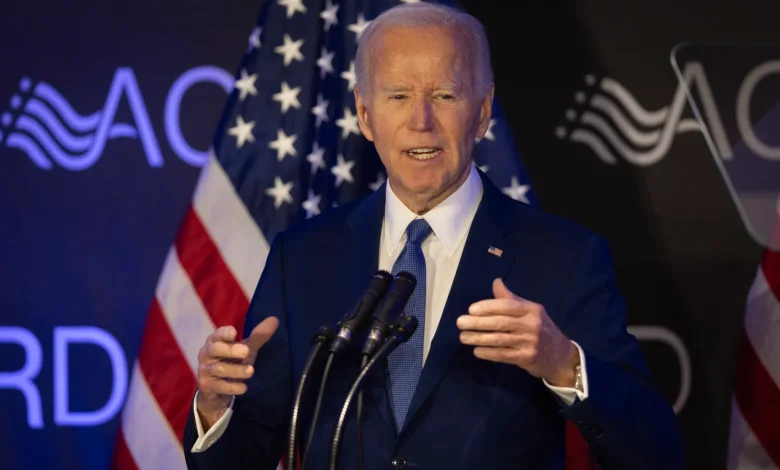Biden Starts Radiation Therapy Amid Prostate Cancer Diagnosis

When high public figures face serious health challenges, the intersection of politics, medicine, and public perception becomes front and center. In October 2025, former U.S. President Joe Biden’s medical team announced that he had begun radiation therapy as part of his treatment for prostate cancer. This marks a new phase in battling a disease that, though common among older men, can carry significant risks depending on the subtype, spread, and response to treatment. The announcement has prompted intense media coverage, speculation, and broader reflections on health, aging, and leadership.
What is known so far: the timeline of Biden’s diagnosis, the nature of his cancer, what radiation therapy entails, the challenges and risks, public and political reactions, and what this might signify in a broader social context.
Timeline & Diagnosis
Discovery and Initial Disclosure
- In May 2025, Biden publicly revealed that he had been diagnosed with prostate cancer that had metastasized to his bone.
- His medical team disclosed that the cancer was considered aggressive, with a Gleason score of 9, indicating a high-grade tumor.
- At that time, Biden stated that the cancer had not spread to his internal organs and that his bones remained “strong.”
- His statement included optimism: “We’re going to be able to beat this,” and he characterized his prognosis as favorable given the cancer’s apparent responsiveness to hormone therapy.
- The initial treatment involved hormone therapy, specifically oral medication, with a regimen described as spanning about six weeks initially. Move to Radiation Therapy
- In October 2025, Biden’s office confirmed that he had begun radiation therapy in conjunction with continuing hormone treatment.
- According to media reports, this radiation course is expected to last roughly five weeks.
- The medical team describes Biden’s cancer as “hormone-sensitive,” meaning his tumor growth depends, at least in part, on male hormones (androgens), which can be targeted therapeutically.
- Additionally, during this period, Biden underwent Mohs surgery to remove skin lesions—this was disclosed separately from the prostate cancer treatment, but it contributes to the public’s holistic understanding of his health status.
Thus, the decision to initiate radiation is a clear signal that Biden’s medical team considers a more aggressive, multimodal approach necessary at this stage, likely to consolidate gains achieved by hormone therapy and to directly attack local disease in the prostate region (or suspected residual cancer cell sites).
Understanding the Disease: Prostate Cancer, Gleason Score, and Metastasis
To appreciate the significance of Biden’s treatment, it is useful to review some clinical background.
Prostate Cancer Overview
Prostate cancer is one of the most common cancers among men, especially older men. Many prostate cancers develop slowly and may never cause symptoms or require treatment. However, some variants are aggressive, invade nearby tissues, or metastasize to distant sites such as bone.
Gleason Score and Aggressiveness
The Gleason scoring system grades prostate tumors based on how abnormal the cells look under a microscope. Scores range from 6 (least aggressive) to 10 (most aggressive). A score of 9 indicates a highly aggressive tumor composed of poorly differentiated cancer cells.
High Gleason scores are correlated with increased likelihood of spread (metastasis), resistance to therapy, and poorer outcomes if untreated.
Metastasis to Bone and Hormone Sensitivity
In Biden’s case, the cancer has already spread to bone (i.e., metastatic disease).
Bone metastases complicate treatment because systemic (whole-body) therapy is needed, and achieving a cure becomes much more difficult. Still, many metastatic prostate cancers are hormone-sensitive, meaning they still respond to therapies that suppress or block male hormones (testosterone, etc.).
When hormone therapy works, it can slow disease progression, reduce tumor burden, relieve symptoms, and prolong survival. But in high-risk cases, combining hormone therapy with other modalities (radiation, chemotherapy, newer targeted agents) is often required.
Thus, Biden’s diagnosis places him in a challenging but not hopeless category: high-grade, metastatic, but with features (hormone sensitivity) that can make aggressive treatment a viable option.
Radiation Therapy: Purpose, Modalities, and Role in Treatment
Radiation therapy (or radiotherapy) uses ionizing radiation to kill cancer cells or stop them from dividing. It is a cornerstone in cancer treatment and is often used either alone or in combination with other therapies.
Goals of Radiation in Prostate Cancer
In a context like Biden’s, radiation may aim to:
- Eradicate or control residual tumor cells in the prostate or adjacent region that remain vulnerable after hormone therapy.
- Reduce the risk of local relapse (i.e., cancer re‐growing in the prostate region, which could cause pain, urinary symptoms, or further spread).
- Provide palliative relief — especially in the case of bone metastases, radiation directed to bone lesions can reduce pain, prevent fractures, or stabilize skeletal integrity.
- Complement systemic therapy like hormone suppression, making the overall approach more effective.
The fact that Biden’s therapy is planned for about five weeks suggests a conventional external beam radiation schedule, likely delivered daily or near-daily, targeting the prostate and possibly extending margins to cover regions at risk.
Types of Radiation Modalities
- External Beam Radiation Therapy (EBRT): The most common approach. High-energy beams, often generated by linear accelerators, are directed at the prostate and surrounding tissues. Modern techniques (e.g. intensity-modulated radiation therapy, image-guided radiation therapy) allow precise targeting to minimize damage to nearby organs (bladder, rectum, etc.).
- Brachytherapy (internal radiation): Insertion of radioactive seeds directly into or near the tumor; sometimes used in localized disease but less so in metastatic settings unless for symptom control.
- Stereotactic Body Radiation Therapy (SBRT): Delivers very high doses over fewer sessions. Could be considered in some prostate cancer settings, though it is more technically demanding when combined with hormone therapy and metastatic disease.
- Radionuclide therapy / targeted radiation: For bone metastases, agents like radium-223 may deliver systemic radiation targeting bone lesions. (Though at the moment, reports haven’t indicated Biden is receiving such treatments.)
In Biden’s case, the reported timing and duration favor conventional EBRT as part of a combined modality strategy.
Interaction With Hormone Therapy
Radiation is often more effective when combined with androgen deprivation therapy (ADT, i.e. hormone suppression). Lowering androgen levels makes cancer cells more sensitive to radiation damage. In high-risk and metastatic prostate cancer settings, this combination is a standard of care. Over time, the synergistic effect can help suppress tumor growth better than either therapy alone.
However, combining treatments also raises the risk of overlapping side effects, which must be managed carefully.
Risks, Side Effects, and Management
Every cancer therapy has risks. In elderly patients especially, tolerance and side‐effect management become crucial.
Common Side Effects of Radiation to the Prostate Region
- Urinary (genitourinary) symptoms:
- Urgency, frequency, or discomfort during urination (dysuria)
- Increased nocturia (nighttime urination)
- Hematuria (blood in urine) in some cases
- Potential obstruction or stricture formation (with long-term risk)
- Bowel (gastrointestinal) symptoms:
- Diarrhea, rectal urgency
- Cramping, rectal pain, or bleeding (proctitis)
- Irritation of rectal mucosa, leading to chronic rectal bleeding in rare cases
- Sexual dysfunction:
- Erection difficulties can worsen, especially in those with prior baseline erectile dysfunction (common in older men); radiation and hormone therapy both contribute.
- Fatigue:
- General fatigue and malaise are common, often peaking toward the end of treatment.
- Secondary risks:
- Rarely, radiation may damage adjacent organs (e.g. bladder, bowel) in a permanent way if not carefully planned.
- Risk of radiation-induced secondary malignancies over very long term (less common, and of lower relative risk given patient age).
Additional Risks in the Metastatic Setting and in an Older Patient
- Bone health and fracture risk: Since Biden’s cancer has already metastasized to bone, maintaining skeletal integrity is critical. Radiation to bone may help control pain and reduce local progression, but careful planning is essential to avoid artificial weakening of the bone structure.
- Cumulative toxicity with hormone therapy: Long-term androgen deprivation is associated with side effects such as decreased bone density (osteoporosis), metabolic changes (insulin resistance, lipids), cardiovascular risk, muscle weakness, and mood changes.
- Comorbidities and frailty: At age 82, Biden’s physiological resilience is a concern. Underlying cardiovascular, renal, or other age-related health issues may limit how aggressively therapy can be pursued or may lead to more pronounced side effects.
- Quality of life tradeoffs: Balancing tumor control with maintaining quality of life is often more challenging in older patients. Side effects must be mitigated to avoid undue suffering.
Mitigation Strategies & Supportive Care
- Advanced radiation planning: Use of image-guided radiotherapy (IGRT), intensity-modulated radiotherapy (IMRT), or proton therapy (if available) to spare normal tissues.
- Fractionation strategies: Adjusting dose per session and number of total sessions to minimize acute toxicity.
- Medications and symptomatic care: Alpha blockers or anticholinergics to ease urinary symptoms; anti-diarrheal agents or stool softeners; pain medications; nutritional support.
- Bone protection: Use of bone-strengthening agents (e.g. bisphosphonates or denosumab), calcium and vitamin D supplementation, and monitoring bone health.
- Close monitoring: Frequent follow-up with labs, imaging, and symptom assessments to catch adverse effects early.
- Supportive therapies: Physical therapy, nutritional support, and psychological counseling to help the patient remain as functional and comfortable as possible.
Given Biden’s public status, his medical team is likely adopting a conservative but proactive posture to balance efficacy and tolerability.
Public & Political Repercussions
Transparency, Trust, and Political Implications
As a high-profile political figure, Biden’s cancer diagnosis and treatment invite scrutiny, speculation, and demands for transparency. Some key dynamics:
- Public confidence and perception: Voters and analysts will closely watch how openly his team shares updates, how he appears publicly, and how his performance is affected. Health often becomes a proxy for readiness or capacity for leadership.
- Media scrutiny and narrative framing: Various outlets will interpret his condition in political light — some emphasizing vulnerability, others resilience. Mis- or disinformation can also emerge.
- Comparisons with past presidencies: The U.S. has seen presidents handle serious illnesses while in office (e.g. Franklin D. Roosevelt, Ronald Reagan, John F. Kennedy). Managing a cancer diagnosis may evoke both sympathy and strategic concerns about continuity of leadership.
- Legacy and symbolism: Biden has long emphasized cancer research, notably through his “Cancer Moonshot” initiative. His own diagnosis and treatment could become part of his legacy narrative: the leader who also became a patient and exacted greater urgency on cancer research.
- Health policy discourse: His situation may reignite debates about access to care, research funding, personalized medicine, and the role of government in health. It could bolster political momentum for increased investment in oncology research or health equity.
Public Reaction
The news elicited varied reactions:
- Many expressed sympathy and support, applauding his decision to disclose and face treatment publicly.
- Others questioned whether earlier disclosure or screening might have altered the course.
- Some pundits speculated whether his health contributed to his withdrawal from the 2024 re-election bid (he had ended his campaign partly under pressure over age, performance, and cognitive fitness).
- Others saw the development as a challenging political factor: would his medical condition affect his ability to stay active publicly, make decisions, or engage in rigorous travel or diplomacy?
In short, the announcement is not just medical news — it is also political theater, and how the public processes it will influence both Biden’s legacy and broader conversations about aging, public service, and the human side of higher office.
Prognosis, Challenges, and Possible Scenarios
While no one can predict with certainty, some possible trajectories and challenges emerge based on known data.
Best-Case Scenario
- The combination of hormone therapy plus radiation results in durable suppression of disease, arresting tumor growth upstream and downstream.
- Biden’s quality of life remains relatively preserved, with manageable side effects.
- The cancer does not progress significantly for several years, allowing him to remain active in public life (albeit in a limited capacity).
- This kind of “chronic disease” model — where cancer becomes a long-term but controllable condition — is increasingly common in oncology, particularly for hormone-sensitive prostate cancer.
Intermediate / Stable Scenario
- Treatment yields control for a time, but periodic disease progression occurs, requiring further therapy (e.g. newer androgen receptor–targeted agents, chemotherapy, immunotherapy).
- Side effects become more persistent or burdensome, limiting how intensively therapy can be escalated.
- His public presence may be reduced, as he balances medical demands, fatigue, and functional constraints.
Worst-Case / Rapid Progression Scenario
- Despite therapy, the cancer may evolve into a castration-resistant (hormone-insensitive) phenotype, at which point it becomes more difficult to manage.
- Metastasis could advance, involving organs or the central nervous system, complicating treatment and prognosis.
- The side effects or comorbidities (e.g. cardiovascular disease, frailty) could exacerbate risks of complications or reduce therapeutic options.
However, several moderating factors tilt toward hope:
- Hormone sensitivity: The fact that Biden’s cancer appears to respond to hormone therapy suggests it has not yet evolved to a resistant phenotype.
- Multimodal approach: Using radiation in conjunction with hormone therapy is standard in high-risk settings and improves outcomes compared to monotherapy.
- Medical resources and monitoring: Biden’s access to top-tier care, frequent monitoring, and responsive adjustments to therapy give his team advantages in mitigating risks.
Broader Reflections: Aging, Health, and Leadership
Beyond the medical and political specifics, Biden’s journey provokes deeper reflection on how societies perceive aging leaders, chronic disease, and human vulnerability.
Normalizing Health Struggles
In many cultures, health challenges are private or stigmatized. When a public figure confronts cancer, it can help normalize the experience — reminding citizens that disease does not discriminate by status. This transparency can reduce stigma and encourage screening, early detection, and empathy. That said, the balance between privacy and public demand for disclosure is delicate.
Leadership Under Physical Limitation
Throughout history, leaders have carried illnesses while in office or public life. The question is: how much should a physical health condition (if managed) count against someone’s capability to contribute intellectually, ethically, and strategically? In modern democracies, demands for transparency, fitness, and capacity grow ever more insistent, sometimes overshadowing substantive discussion of policies or ideas.
The Aging of Politicians in Modern Democracies
As populations age and political careers extend, more leaders will likely face age-related health issues (cardiovascular disease, neurodegenerative disorders, cancers, etc.). The Biden case may represent a future scenario: public figures navigating serious chronic disease within the glare of media and public expectations.
Mobilizing Cancer Awareness and Research
Biden’s own advocacy for cancer research (notably the Cancer Moonshot) took on added resonance when his own diagnosis surfaced. His treatment journey may galvanize renewed public interest in early detection, research funding, disparities in healthcare access, and policy incentives to accelerate innovation.
Conclusion
Joe Biden’s initiation of radiation therapy as part of his treatment against aggressive, metastatic prostate cancer marks a significant moment in a highly publicized health journey. It underscores both the personal challenge of a serious diagnosis and the collective interest in how leaders confront mortality, illness, and aging.
While uncertainties abound, the available information suggests a reasoned, aggressive, and carefully calibrated medical approach: combining hormone therapy with radiation to maximize disease control while managing toxicity. How Biden’s health evolves will depend on many factors: biological response, timely adjustments in therapy, side effect management, and his overall physiological resilience.
In the weeks and months ahead, the public will scrutinize both his medical progress and how he navigates his public role. Beyond politics, his story may help destigmatize cancer, spur conversations about aging leadership, and mobilize further attention to cancer science and compassionate care.




